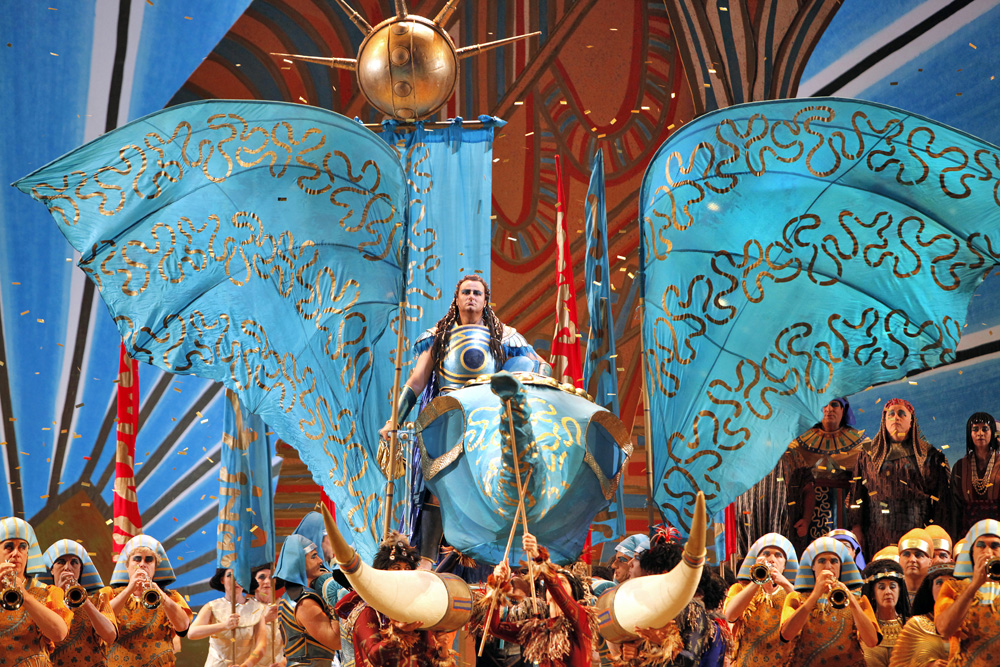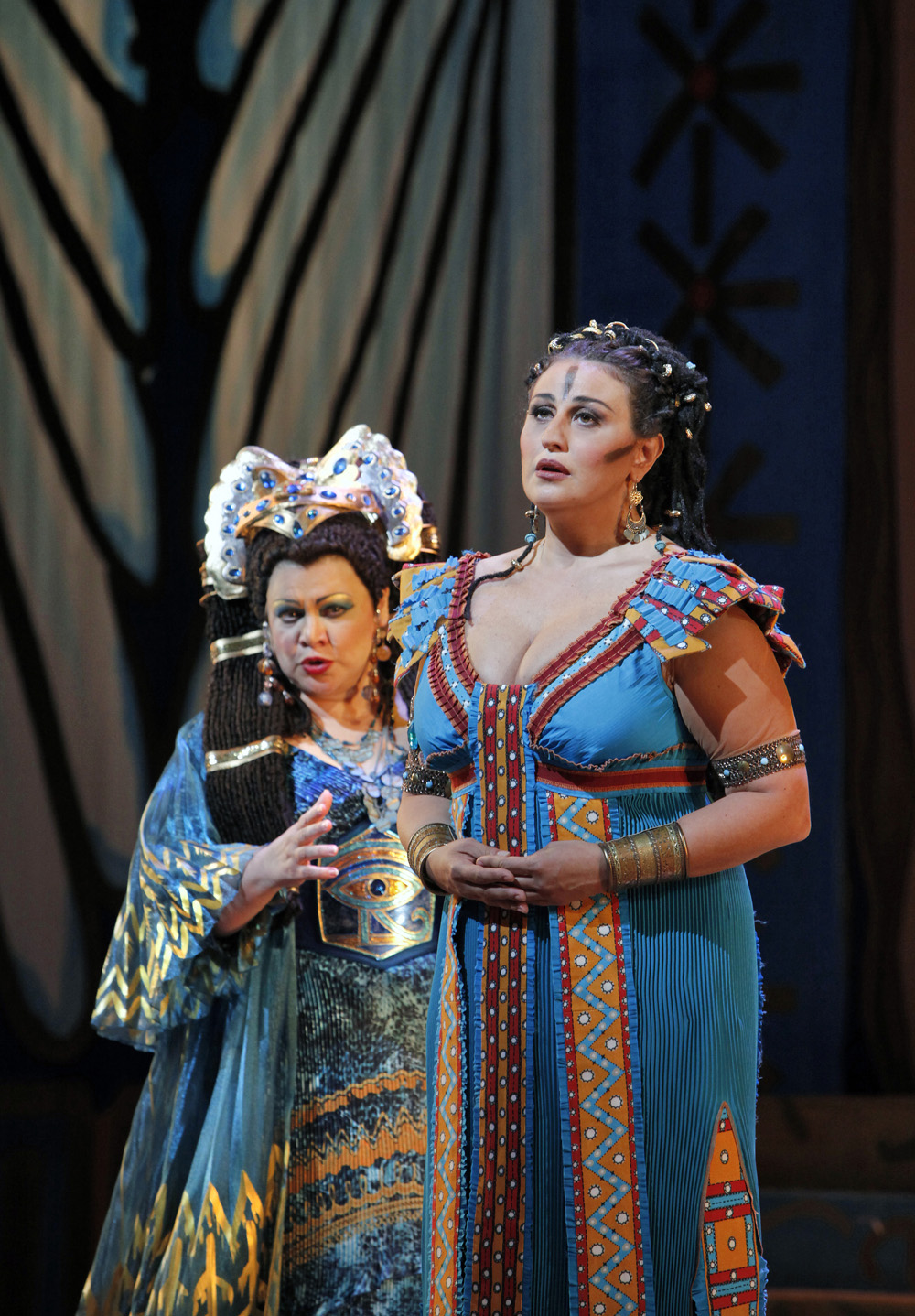Fiery vocalism elevates mixed “Aida” at San Francisco Opera

Radames (Marcello Giordani) makes a triumphant entrance in San Francisco Opera's production of "Aida." Photo: Cory Weaver
San Francisco Opera has had a long and distinguished history with Verdi’s Aida. Claudia Muzio was the company’s first Ethiopian princess in 1925, Mario del Monaco made his U.S. debut as Radames here in 1950, and in 1957 Leontyne Price first sang her most celebrated role in San Francisco.
There are two main points of interest in the company’s current production of Verdi’s Egyptian fable of love, jealousy, betrayal, big animals and involuntary entombment: Marcello Giordani in his role debut as Radames, and the scenic design by the once-outre punk fashion stylist Zandra Rhodes.
When David Gockley walked onstage Friday night, some in the audience groaned, anticipating an announcement that one of the principals was indisposed for the evening’s performance.
No fear. The company’s general director was there to note that the night’s performance was being simulcast live to AT&T Field, the home of the playoff-contending Giants, where an estimated 32,000 watched. Hopefully, the reception was better than AT&T provides for its similarly entombed iPhone users.
For this production, first unveiled at Houston Grand Opera, the pink-haired designer Rhodes has provided mostly stunning costumes with turquoise as the leitmotif. Without being revisionist, the outfits are traditional with modern flair, her designs for the principals, chorus and dancers were colorful, imaginative and often eye-popping. Only the arboreal Star Wars getups for the priests in Act 3 seemed a mistake.
Unfortunately, Rhodes’ striking costumes were allied to some of the most cosmically ugly set designs I’ve ever experienced. Her idea seemed to be to get away from the traditional polished gold and jeweled elegance to a more rough-edged, folkish style.
Whatever the intent or historical justification, the brightly colored columns in Act 1 resembled bad Mexican folk-art souvenirs, and the huge hieroglyph-like symbols and consciously crude painted sets merely looked amateurish, as if created by children for a grade-school play and ungifted children at that.
As is the case in our economically down-sized times the Triumphal March was less elaborate than in days of yore, but undeniably lively and colorful with some acrobatic dancers. The audience clearly loved the Lion King-esque billowing blue elephant on which Radames makes his entrance.
Musically, San Francisco Opera’s Aida proved more consistent, though it took a while Friday night to gain traction. Giordani’s Celeste Aida was less than earth-shaking; top notes were resonant and with the requisite Italianate ping, yet decidedly short-breathed in expression with phrase ends curtailed.
Once past that hurdle, Giordani vocally went from strength to strength. His clarion tone cut through the massed ensembles of Act 2, and he sang with dramatic frisson and consistently rich, heroic tone. The Sicilian tenor is also one of our finest actors and his ease on stage and natural reactions made a believable tragic figure in an opera that can have a stiff, pageant-like quality.

Dolora Zajick as Amneris and Micaela Carosi in the title role of Verdi's "Aida."Photo: Cory Weaver.
As with Rhodes’ production, Micaela Carosi was a mixed blessing in the title role of the Ethiopian princess. The Italian soprano possesses a bright clear voice with sufficient power on top, and is a solid actress. But apart from some lovely soft singing at the end of O patria mia, she brought little else to the role. Carosi’s vocalism was blandly non-expressive and dynamically straightened at too many key moments—as with her loud and insensitive O terra addio—and technically inconsistent, with fitfully wayward pitch. The fact that Carosi has sung this role at the Met and Covent Garden demonstrates the continuing paucity of true Verdi sopranos.
No such reservations about Dolora Zajick’s Amneris. The popular singer brought her ample mezzo and fiery intensity to the role of the King’s jealous daughter, and her confrontation scene with Giordani’s Radames was the high point of the evening.
Marco Vratogna made a terrific Amonasro, embittered in his raging and consistently enlivening the stage action with his presence and vocalism. Hao Jiang Tin was a sturdy Ramfis, and it was luxury casting to have the superb Christian Van Horn as a dignified King of Egypt.
Director Jo Davies largely moved the chaotic traffic efficiently, apart from some odd conceits like the toy-soldier-like marching about in the Trimphal Scene. It was also a bad idea to bring Zajick’s Amneris on stage alongside the doomed lovers in the final scene, which completely took us out of the tragic coda.
The partnership of Nicola Luisotti, in his second season as SFO music director, with the orchestra still seems like a work in progress. The opening scene and too many quiet passages sounded curiously offhand, dynamically stark and lacking in tension. Yet the Italian conductor brought ample fervor to the ensemble scenes and supported his singers sensitively in their important moments. Ian Robertson’s San Francisco Opera Chorus sang magnificently.
Aida runs through Dec. 5. Principals for the November and December performances are Michele Capalbo as Aida, Carlo Ventre as Radames, Guang Yang as Amneris, and Quinn Kelsey as Amonasro. sfopera.com; 415-864-3330.